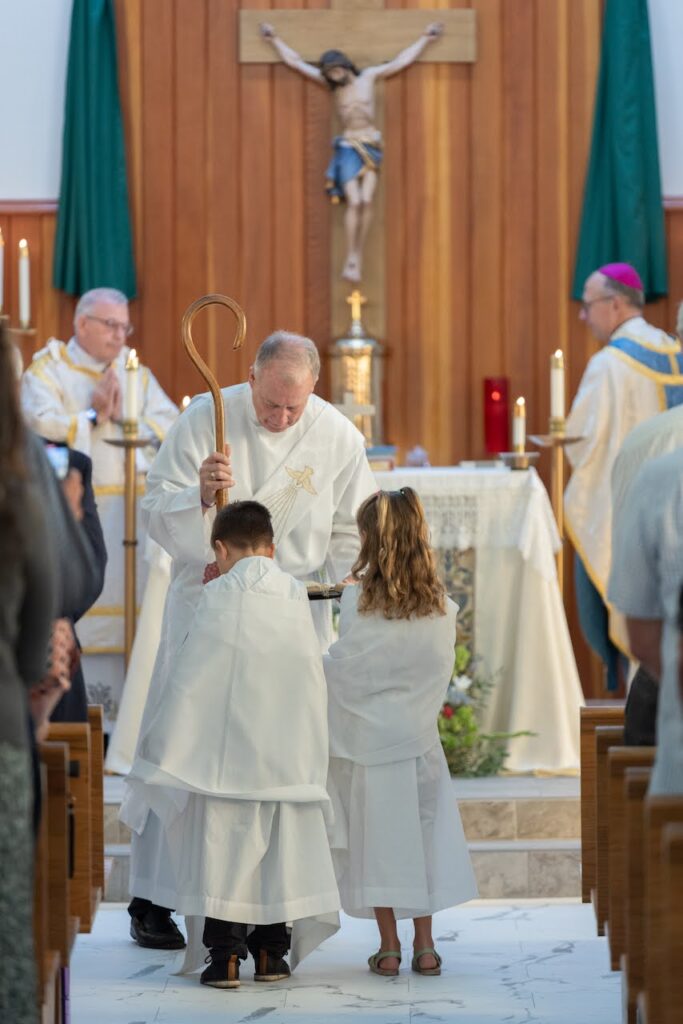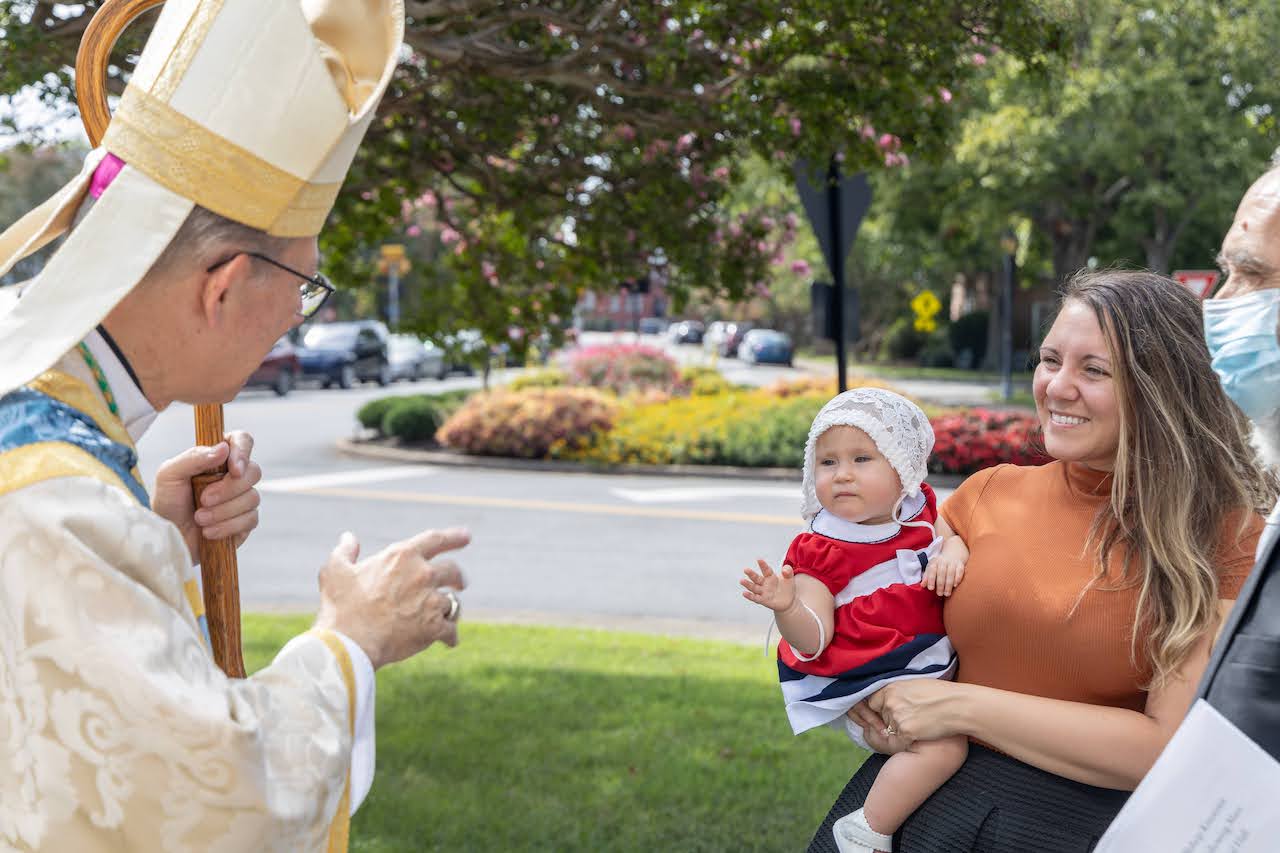In September 1823, Father Thomas Hore celebrated the first recorded Catholic Mass to be held on Virginia’s lower peninsula. It happened less than 40 years after the Virginia General Assembly enacted the Virginia Statute of Religious Freedom into law, disestablishing the Church of England in the commonwealth and protecting the religious freedom of people of all faiths.
The priest was a missionary newly arrived from Ireland; his congregation, Army personnel and construction workers engaged in building the new Fortress Monroe.
“Before then, it wasn’t easy to be Catholic in Virginia,” said Donna Farrell, a parishioner of St. Mary Star of the Sea, on Fort Monroe in Hampton, who has researched the history of the parish.
The day marked a turning of the tide for Catholicism in the commonwealth. By September 1860, the cornerstone would be laid near the site for a new church: St. Mary Star of the Sea.
On Sunday, Sept. 10, Bishop Barry C. Knestout presided over a Mass honoring the 200th anniversary of that first gathering at Fortress Monroe and the 163rd anniversary of the parish.
Father Romeo Jazmin and Father Dillon Bruce, pastor and parochial vicar of St. Mary Star of the Sea, concelebrated, and a reception was held in the parish hall afterward.
“The site has such a unique history,” Farrell said. “It’s a real special place. You can just feel the spirit of those who lived and died for their country, who passed through there and worshiped there through the years.”
Two or three gathered
Two years after the founding of Jamestown, colonists built a wooden stockade, Fort Algernourne, at what is today called Old Point Comfort, to guard the mouth of Hampton Roads.
“The archeological record shows that, even then, there were Catholics at Jamestown. There have always been two or three gathered,” Bishop Knestout said, addressing the congregation.
Catholicism may have been “underground,” but there were always “people gathering and praying, as these great events of history were unfolding in the world around them,” he said.
Priests ministered to French soldiers during the Revolutionary War at the Battle of Yorktown, but it was the aftermath of the War of 1812 that would set the stage for that first recorded Mass on the lower peninsula, Farrell said.
During the conflict, the British commandeered a lighthouse at the point, enabling them to take control of the bay and to burn the city of Hampton to the ground. To prevent such an occurrence from ever happening again, construction began on Fort Monroe and Fort Calhoun — later named Fort Wool — in 1819.
Just one year later, Virginia would see the arrival of a small group of missionary priests from Ireland, who, under the decree of Pope Pius VII, had come to found the Diocese of Richmond.
A new diocese
Father Patrick Kelly was serving as the president of Birchfield College in Kilkenny, Ireland, when he was appointed first bishop of the Diocese of Richmond, a new diocese carved out of the Archdiocese of Baltimore and encompassing the entire commonwealth.
He arrived in Virginia accompanied by several priests and by Thomas Hore, who had recently completed his theological studies at Father Kelly’s school.
On their arrival, then-Bishop Kelly ordained Father Hore, and, together, the missionaries pastored to the small Catholic communities of Norfolk and Portsmouth, Farrell said.
“There really weren’t enough Catholics in Virginia to support a diocese at that time,” she said, so, in 1822, Bishop Kelly returned to Ireland, and the Diocese of Richmond reverted to the administrative care of the Archdiocese of Baltimore, where it would remain until 1834.
Father Hore, however, remained in Virginia, expanding his circuit to include Old Point Comfort, where construction was underway on Fortress Monroe.
There, he celebrated Mass with those who had been brought to the area, tending to the spiritual care of Army personnel and civilian workers miles from home.
The exact date of the Mass is lost to history, Farrell said, but the sense of community forged there, in communion with Christ, would remain and grow through two hundred years to come.
A light by the sea
Priests from Norfolk would serve Catholics living and working at Old Point Comfort until, in June 1860, Bishop John McGill, third bishop of the diocese, and Col. René E. De Russy, representing the U.S. Army Corps of Engineers, signed an agreement allowing for the construction of a Catholic church at Fort Monroe.
“It was begun under President James Buchanan, but then was confirmed by Abraham Lincoln,” Farrell said. Under the terms of the agreement, the diocese would own the church and rectory, but the government would retain ownership of the land.
On September 9, 1860, Bishop McGill dedicated the new church: St. Mary Star of the Sea. Early accounts describe the chapel as a simple, one-story framed building painted either red or black.
It was replaced in 1903 by the small stone church that stands at Fort Monroe today.

The parish has done much to preserve the historic building, Father Bruce said.
“It’s a place to come to appreciate those who have gone before us,” he said. “We’ve restored the floors and have worked to preserve the stained-glass windows, which are from the original building. It’s a really, really beautiful church. It’s calm, it’s peaceful. It’s just a wonderful place to pray.”
A place to call home
“It’s interesting to understand how, from St. Mary Star of the Sea, Catholicism spread throughout the peninsula — with the mission parishes of St. Vincent de Paul and then St. Joseph,” Father Bruce said.
By the time of Fort Monroe’s decommissioning in 2011, St. Mary Star of the Sea was the last diocesan church to stand on an active military installation. It then joined its former mission churches, dedicated in 1881 and 1968, respectively, to form the Peninsula Cluster.
“They came together, and now they’re sticking together,” Father Bruce said, laughing.
Right outside of Fort Monroe, on the other side of Mill Creek, there is also Saint Mary Star of the Sea School, which opened its doors in 1923.
Today, you’re more likely to see children in the blue polo shirts and plaid dresses of Saint Mary Star of the Sea School than soldiers in uniform at Mass, but, like much of Hampton Roads, the parish maintains a spirit of military life. The church provides a constant, Farrell said, for families whose military moves often bring them full circle.

“The nice thing about St. Mary Star of the Sea is that it attracts a lot of people who served in this area. There are some who were stationed here, and then they came back many years later. This is where they found a home,” she said.
“We just love it,” parishioner Doreen Grimm said. “We never miss a Sunday.”
Her husband, Russell ‘Skip’ Grimm, said he lived at Fort Monroe as a child during the 1960s, when his father was stationed there with the Army. He wasn’t Catholic, he said, but now the couple attends St. Mary together.
It’s a place where “the history just draws you in,” Doreen Grimm said, but where the sense of community leads you to stay.
“Everyone here is so lovely,” she said.
It’s this steadfast faith amidst “a history of ebb and flow,” Bishop Knestout said, that has seen St. Mary Star of the Sea through two world wars and into the start of a new century.
“All the while, we have had the presence of the Church and people of God gathered in prayer, watching and seeking guidance from the Lord,” he said. “It’s a beautiful history of watching and praying. Just like Our Lady Star of the Sea.”

